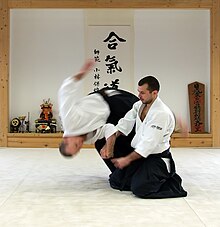Aikido

A version of the "four-direction throw" (shihōnage) with standing attacker and seated defender.
|
|
| Focus | Grappling and softness |
|---|---|
| Country of origin | Japan |
| Creator | Morihei Ueshiba |
| Famous practitioners | Kisshomaru Ueshiba, Moriteru Ueshiba, Christian Tissier, Morihiro Saito, Koichi Tohei, Yoshimitsu Yamada, Gozo Shioda, Mitsugi Saotome, Steven Seagal |
| Ancestor arts | Daitō-ryū Aiki-jūjutsu |
Aikido (Japanese: 合気道 Hepburn: aikidō?) [aikiꜜdoː] is a modern Japanese martial art developed by Morihei Ueshiba as a synthesis of his martial studies, philosophy, and religious beliefs. Aikido is often translated as "the way of unifying (with) life energy" or as "the way of harmonious spirit". Ueshiba's goal was to create an art that practitioners could use to defend themselves while also protecting their attacker from injury.
Aikido techniques consist of entering and turning movements that redirect the momentum of an opponent's attack, and a throw or joint lock that terminates the technique.
Aikido derives mainly from the martial art of Daitō-ryū Aiki-jūjutsu, but began to diverge from it in the late 1920s, partly due to Ueshiba's involvement with the Ōmoto-kyō religion. Ueshiba's early students' documents bear the term aiki-jūjutsu.
Ueshiba's senior students have different approaches to aikido, depending partly on when they studied with him. Today aikido is found all over the world in a number of styles, with broad ranges of interpretation and emphasis. However, they all share techniques formulated by Ueshiba and most have concern for the well-being of the attacker.
The word "aikido" is formed of three kanji:
The term "aiki" does not readily appear in the Japanese language outside the scope of Budo. This has led to many possible interpretations of the word. 合 is mainly used in compounds to mean 'combine, unite, join together, meet', examples being 合同 (combined/united), 合成 (composition), 結合 (unite/combine/join together), 連合 (union/alliance/association), 統合 (combine/unify), and 合意 (mutual agreement). There is an idea of reciprocity, 知り合う (to get to know one another), 話し合い (talk/discussion/negotiation), and 待ち合わせる (meet by appointment).
...
Wikipedia
